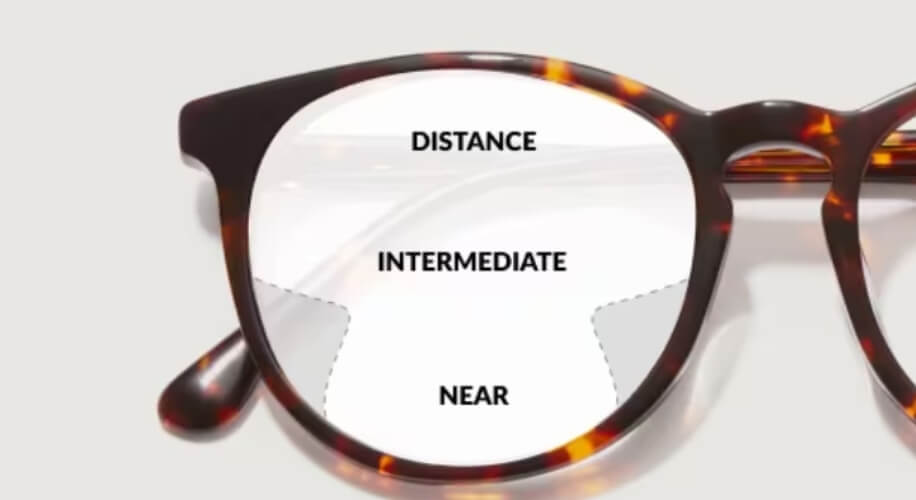A Guide to Adjusting to New Progressive Lenses

Embarking on the journey with progressive lenses can be a transformative experience, offering you a seamless transition across different viewing distances without the need for multiple pairs of glasses. If you’re new to progressive lenses, adapting to them may take a bit of time and patience. However, with a few practical tips, you can accelerate this adjustment period and enjoy the full benefits of your new eyewear. Let’s explore how you can effectively adapt to your progressive lenses and get back to seeing the world with clarity and comfort.
Shop Frame
Understanding Your Progressive Lenses
Before diving into the tips for adjustment, it’s crucial to have a basic understanding of the parts of your progressive lenses. These lenses are meticulously crafted with three main viewing areas:
- The upper portion is designed for distance vision, perfect for driving or taking in a scenic view.
- The middle section provides a smooth gradient for intermediate distances, such as computer screens or store shelves.
- The lower segment is optimized for reading and other close-up tasks, like texting on your phone or enjoying a good book.
Knowing where these areas are located on your lenses and what they’re used for is the first step to using them effectively.

Essential Tips for Quick Adaptation
Adjustment to progressive lenses is a personal experience and can vary from person to person. However, these tips are universally helpful in making the transition smoother:
Start with a Positive Mindset
Embrace your new lenses with an open mind. Trust that your eyes and brain will adapt to the new viewing areas. A positive mindset can significantly enhance your adaptation process.
Wear Your Progressives Full-Time
Consistency is key. Make your progressive lenses your primary eyewear, wearing them from the moment you wake up until you go to bed. This will help your vision adapt more quickly as your eyes will learn to naturally find the right part of the lens to look through for different activities.
Maintain Proper Head and Eye Movement
With progressives, it’s important to move your head and eyes rather than just glancing down or to the side. Practice pointing your nose toward what you want to focus on and allow your eyes to follow. This ensures you’re looking through the correct part of the lens and helps reduce the sensation of swimming or swaying that some wearers initially experience.
Take Your Time
Give yourself a grace period to get used to your new lenses. Start by focusing on stationary objects before moving on to tasks that require more dynamic vision, like walking up and down stairs or driving.
Check Your Frame Fit
Ensure your glasses fit properly and are correctly aligned with your eyes. An improper fit can interfere with how you see through your progressive lenses. If necessary, visit your eyewear provider to have your frames adjusted for the most comfortable fit.
Shop Frame
Navigating Common Challenges
While adapting to progressive lenses, you may encounter a few hurdles along the way:
- If you experience blurry vision, ensure you’re looking through the right part of the lens for your current activity. If blurriness persists, consult your eyecare provider as your prescription may need an adjustment.
- Some users feel a sense of motion or distortion, particularly in the peripheral areas of the lenses. This usually diminishes as you adjust, but practicing head movements as suggested can help minimize this feeling.
- For those who spend long hours in front of digital screens, it’s essential to position your monitor correctly. The screen should be at a comfortable distance, slightly below eye level, allowing you to view it through the intermediate section of your lenses.
Remember, patience is vital. Most people adjust to their progressive lenses within a couple of weeks, but some may take a little longer. If you continue to have difficulties after a reasonable adjustment period, don’t hesitate to reach out to your eyecare professional for advice or a possible prescription check. At Zenni Optical, we understand the importance of a seamless transition to progressive lenses and we are here to support you every step of the way.
About the Author: Dr. Sophia Moh, OD, ABOC
Dr. Sophia Moh, OD, is an optometrist based in the Bay Area, California. She holds a doctorate from UC Berkeley School of Optometry and has worked in various eye care settings, including primary care optometry, general ophthalmology, community health clinics, and Veterans Affairs. Dr. Moh is dedicated to improving global vision health by making high-quality, affordable eyewear accessible to all. She is also a certified American Board Optician (ABO) and actively contributes to optical education through training and lectures.




 Canada
Canada